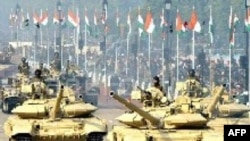The bill, which now goes to the upper house, can be seen as confirmation of a decree issued by President Vladimir Putin in July, which announced Russia’s halt to its participation in the treaty after a 150-day mandatory waiting period.
The CFE Treaty took NATO and the former Warsaw Pact 10 years to negotiate.
It came into force in 1992 and set limits on the deployment between the Atlantic Ocean and the Urals of conventional heavy weaponry such as tanks, artillery, and aircraft, and provided for regular mutual inspections.
Following the breakup of the Eastern bloc, a revised treaty, CFE II, was negotiated in Istanbul in 1999 to reflect the new post-Soviet landscape by setting arms limits for individual countries.
However, only four countries -- Belarus, Kazakhstan, Russia, and Ukraine -- ratified the revised treaty. NATO countries did not ratify it, saying they would do so only after Russia complied with commitments it made to remove its troops and equipment from Georgia and Moldova.
That has been the main point of disagreement between Moscow and NATO ever since.
Following the failure to reach agreement on this and other issues -- particularly on the planned deployment of a U.S. missile-defense shield in Central Europe -- Putin issued a decree on July 14 stating that Moscow would suspend its participation in the original CFE Treaty.
Today, following the Duma vote, Russian Foreign Minister Sergei Lavrov explained that Moscow is not repealing its ratification of the amended CFE Treaty. "We are only suspending our participation in a treaty that is hopelessly out of date," Lavrov said. "And we are waiting for all other participants of the CFE Treaty to ratify the amended version so it can be implemented and modernized with the consideration of new realities."
There was no immediate reaction from the Organization for Security and Cooperation in Europe (OSCE). Although it is not an OSCE agreement, the CFE Treaty was negotiated in parallel with confidence-building talks among participating states of the Conference on Security and Cooperation in Europe, the forerunner to the OSCE.
According to Putin’s original decree, Russia’s suspension of its participation in the CFE Treaty should come into force next month.
Until now, NATO has said its members will continue to abide by the treaty’s provisions, even though its members will not ratify it until Moscow pulls its troops out of Georgia and Moldova.
Conventional Forces In Europe
 A Russian soldier watching Russian armaments leave Georgia in 2006 (epa)
A Russian soldier watching Russian armaments leave Georgia in 2006 (epa)
AGREEMENTS ON CONVENTIONAL FORCES IN EUROPE. The CFE treaty is an arms-control agreement originally negotiated between NATO and the Warsaw Pact as a guarantor of European security in Europe in the waning days of the Cold War.
- The original CFE Treaty took 10 years to negotiate, was signed by 30 states ** in November 1990, and came in to force in 1992. Its aim: to reduce stockpiles of conventional armaments between the Atlantic Ocean and the Ural mountains.
The blocs limited themselves to:
20,000 tanks
20,000 artillery pieces
30,000 armored combat vehicles
6,800 combat aircraft
2,000 attack helicopters
- The CFE-1A, a 1992 addendum, has resulted in the withdrawal of more than 700,000 troops from Europe since 2001 and the destruction of 50,000 pieces of military equipment by 1995.
- The CFE-II, negotiated in Istanbul in 1999, reflected the new, post-Soviet landscape by setting arms limits for individual countries, rather than zones. The agreement aided NATO's expansion efforts by allowing signatory states to allow foreign forces on their soil.
- NATO states have not ratified the CFE-II due to concerns over Russia's failure to comply with commitments it made during the negotiations. Under the Istanbul Accords, Russia pledged to set a timetable for closing its remaining military bases in Georgia and to completely withdraw its forces from Moldova.
- The CFE-II will come into force once ratified by all 30 CFE signatories. Thus far only Belarus, Kazakhstan, Russia, and Ukraine have ratified the CFE-II.
- In ratifying the agreement in June 2004, Russia called on the signatories not to delay in ratifying the document. Russia expressed concern that Lithuania, Estonia, and Latvia, as nonmembers of the treaty, could possibly harbor NATO troops near its western border.
(** Armenia, Azerbaijan, Belarus, Belgium, Bulgaria, Canada, Czech Republic, Denmark, France, Georgia, Germany, Greece, Hungary, Iceland, Italy, Kazakhstan, Luxembourg, Moldova, the Netherlands, Norway, Poland, Portugal, Romania, Russia, Slovak Republic, Spain, Turkey, Ukraine, the United Kingdom, and the United States. )















